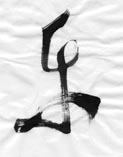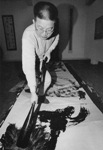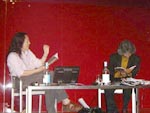Navigation



Poet Yang Lian explores the links between poetry and Chinese landscape paintings at the British Museum
Imagine a world in which there is no singular or plural, no personal indicator and no tense. Where there is no need to specify the I/you/he/she/it/we/you/they or how much of anything is involved or when it has/is/will be taking place. Impossible? Not at all – this is the exhilarating world of Chinese poetry.
Think about it. In the absence of personal pronouns and numerical exactitude, you must rely on your wits, on your instincts, you must keep your eyes, ears and all your senses finely tuned. You must watch out for hidden meaning and structure within what you find. Without tense, the language can move seamlessly between ancient and modern. Without ‘time’ there is only ‘situation’.
In classical Chinese painting, as in Chinese poetry, the personality of the artist is hidden behind form and style, especially in landscape painting. This is quite different from Western painting in which the main figures are usually at the front, with nature as the background. In classical Chinese painting nature is often the subject. Does this mean there is no personality in Chinese painting? No. The personality is transformed into the way of painting. In the exquisite paintings by Gu Kaizhi, the artist’s precise brushstrokes create not only a detailed and realistic view of the court ladies, but also evoke more abstract feelings. Later literati paintings provoke quite different feelings. The bitter persistence of stark, gnarled trees in the harshest wintery conditions convey the cold strength of the artists’ personal determination to survive in culturally shifting, and often politically dangerous, conditions.
To get to the heart of Chinese painting and poetry, you must first step consciously into a landscape created in ink. The space in which you find yourself is determined by form and shows above all the situation of man. ‘Situation’ reflects a timelessness and explains why I feel the Tang dynasty poets Li Bo and Du Fu are my contemporaries. We understand the implications of political exile far from home and so much more. In much the same way, the creators of the classical Chinese landscape paintings currently on display in the British Museum are artists with whom I interact all the time. The creative links are still very much alive.
When I first began to write poetry, one thing was crystal clear in my mind. If I could not find a creative link between the classical Chinese tradition and my own writing, then I would have to declare the tradition dead. There would be no ‘tradition’, only a ‘past’. All my writings – poetry, prose, essays – have focused on these creative links. This is especially true in Concentric Circles, the longest and most important work of poetry I have written since I left China in 1989. Concentric Circles is emphatically not a political work, but is instead focused on ‘deep reality’ and the nature of how humans understand that reality through the medium of language. The book, like the sections of which it is comprised, uses a kind of collage, where many small fragments, each complete in itself, are aligned together in a series of patterns to form a grander mosaic: from line to line, poem to poem, cycle to cycle, in ever-widening concentric structures. The image of concentric circles works in many ways. There are links with the way of thinking in classical Chinese philosophy; there are links between the separateness of my life within China and outside China; between my inside self and my outside self in the company of others. All the so-called ‘differences’ are linked, one to another, and lead the way to an ever deeper question, until finally the innermost circle is reached. To me, it is the unceasing questioning that is the meaning of poetry. Through the structure of poetry, I have sought to remove the limitations of time in order to ascend to a new spatial level of poetry.
Mysteriously, it seemed my good friend, the artist Rebecca Horn understood the poetry of Concentric Circles perfectly without even reading it. Independently of each other, we two artists of different cultural backgrounds shared an understanding of the same concept, combining ancient and modern. My poetry in ink and her installation shared the same internal movement of energy and circles of beautiful form. We even shared the golden colours. Here is proof that amidst the explosive clashes of culture and confusion of language, there is a directness in the poetic and the abstract that transcends borders. Poetic understanding crosses time and culture. These rings are not abstract. They are alive like a bird’s nest, opera-like as the waves hit the ocean coast, shining like the sky where the stars mirror one another, everything held by the sentence ‘Poetry is our mother tongue’.
This article was first published in the British Museum Magazine (52), Summer 2005, pp.11-13. Concentric Circles was published by Bloodaxe Books, June 2005.